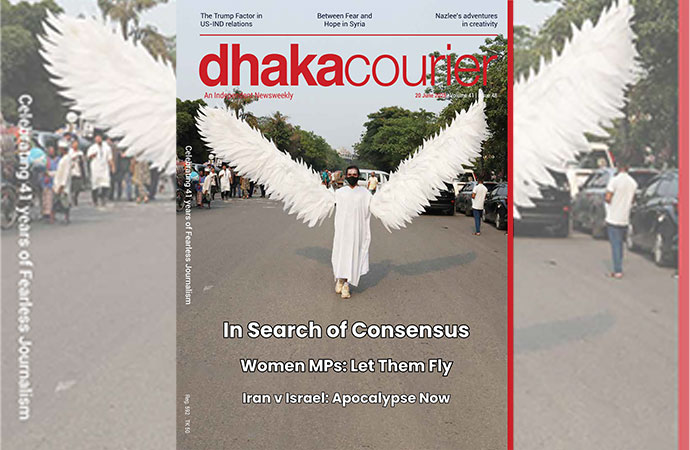Column

freepik
What if beauty were to produce happiness? That is a pertinent question everywhere in this beautiful world but it is 0ne particularly in Bengal, where natural and human beauty has moulded the aesthetic reflexes of poets who enjoy popular agency age after age. Bengal is beautiful in what it creates for humans, and what they create for it in return. Without the green homeliness of its land and the flowing fertility of its rivers, Rabindranath Tagore may not have written of maternal Bengal কী আঁচল বিছায়েছ বটের মূলে, নদীর কূলে কূলে so that every Bengali even in his or her dotage will remember তুই দিন ফুরালে সন্ধ্যাকালে কী দীপ জ্বালিস ঘরে. The Barisal-born Jibanananda Das finds a Bengal-shaped Banalata Sen whose birds'-nest eyes are his eternal sanctuary: At the end of the day, সব পাখি ঘরে আসে/সব নদী ফুরায় এ জীবনের সব লেনদেন,/থাকে শুধু অন্ধকার/মুখোমুখি বসিবার বনলতা সেন। The abrasive agency of Bengal invades the very genes of its people. They cannot give birth to humans who are immune to the beauty of physical, mental and moral landscapes.
But are Bengalis happy? Some are, no doubt. Perhaps many are, in Bangladesh and in West Bengal and in Bengal's diasporic ambit. However, it is difficult to believe that most Bengalis are happy. How can Bengalis be happy when the beauty of their skies and their trees and their rivers and their seasons does not transform the fates of downcast orphans, discarded parents, unemployed workers and the disabled young. What does Bengal's beauty mean to them? And who cares for beauty if it does not belong to all?
There are many answers, but my favourite one lies in Christopher Caudwell's essay, "Beauty", in his Further Studies in a Dying Culture. Rereading that essay after four decades, I found these sentences: "A day may come when man, become increasingly conscious of himself, may be able to make happy things, a happy environment, as he makes a beautiful thing. Happiness will then seem to him like beauty, not in himself but in his environment. He will be the creator, not the slave, of happiness and sorrow, as he is now the creator of beauty and ugliness. Then perhaps happiness will seem higher than beauty, or perhaps it will seem as if beauty, by a simple expansion, has taken up happiness within itself, and it is still beauty, but a larger, more universal beauty which we serve, a happiness which we now consciously create and actually see."
Caudwell was the authorial name of Christopher St. John Sprigg. Born in London in October 1907, he was a polymath in the tradition of the greats of the European Renaissance. He read voraciously in philosophy, sociology, anthropology, psychology, history, politics, linguistics, mathematics, economics, physics, biology, neurology, literature and literary criticism. Best remembered for his Illusion and Reality and Studies in a Dying Culture, he manifested his materialist bent in The Crisis in Physics, where he demystified the incestuous relationship between science and economics. He founded an aeronautical publishing company with his brother, apart from designing an infinitely variable gear. Clearly, he believed in intellect that exists in action. He participated in the Spanish Civil War as a partisan, and was killed by fascists in the valley of Jarama in February 1937. He was only 29.
"A day may come." Those words of Caudwell, who died young, stand as an ageing signpost for those who believe that life is indivisible, that the pursuit of beauty for oneself should lead to the quest for happiness for all. So it must be in Bengal.
How will the day come? The first step towards aesthetic redemption is to delink beauty from nature. Nature is not beautiful because, if it were, cats and dogs (natural beings) would not lie dead and rotting by the wayside. What is beautiful is not nature but the human eye's capacity to understand beauty as symmetry manifested in nature: the symmetry of waiting soil and flowering leaves, rising waves and joyous sails, mischievous children and mothers' laps, poets' lines and maddened readers. The same sense of symmetry must therefore contest dissonances produced by nature: those unbridgeable disparities of wealth, status and knowledge that bifurcate human existence into the avowed realms of success and failure.
Happiness lies in socialising beauty. Elaine Scarry of Harvard makes a convincing case for the social agency of the beautiful when she writes that how "one walks through the world, the endless small adjustments of balance, is affected by the shifting weights of beautiful things." The beautiful creates a lasting desire to locate the enduring sources of the conviction which it inspires. Beauty "prepares us for justice". And equality lies at the heart of beauty because equality is "the morally highest and best feature of the world". The connection with happiness is clear. The moral supreme cannot but contribute to happiness in the unfailing trinity of the True, the God and the Beautiful.
If it did not do so, why ever did Tagore and Jibanananda bother to write about Bengal's beauty, and why do millions of Bengalis find even their unhappy days incomplete without greeting at least a line from those greats once a day, whether they live in Dhaka or Kolkata or London or New York or Cairo or Lagos or Singapore?
Bengalis are beautiful people. The need to be happy people as well. When a Caudwellian day comes.

























Leave a Comment
Recent Posts
The Northeastern Question
When secessionist movements sprang up across the Eastern European part ...
Trump’s Tariff: How far should ...
Will Bangladesh manage to get a last minute reprieve on its 'Trump tar ...
Rivers, Peaks, and Expressions – My Experience at th ..
What lies behind the alarming spike in violence agai ..
A Himalayan choice
Twenty Palestinians were killed at a food distributi ..